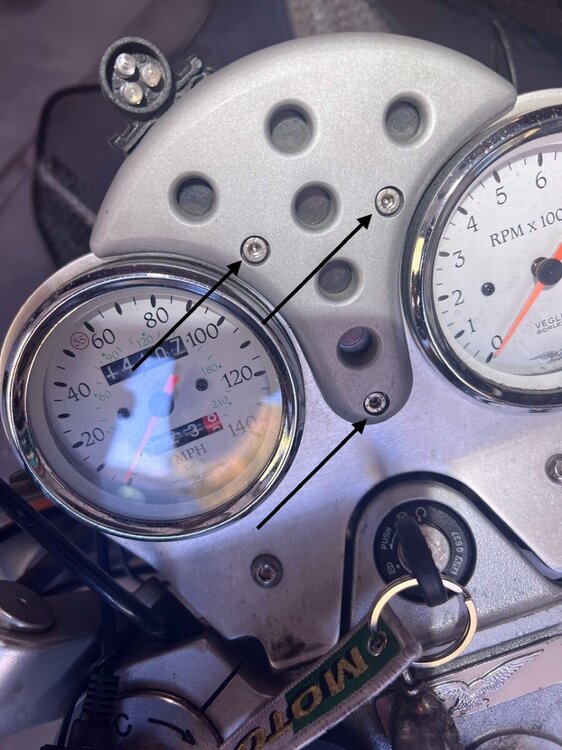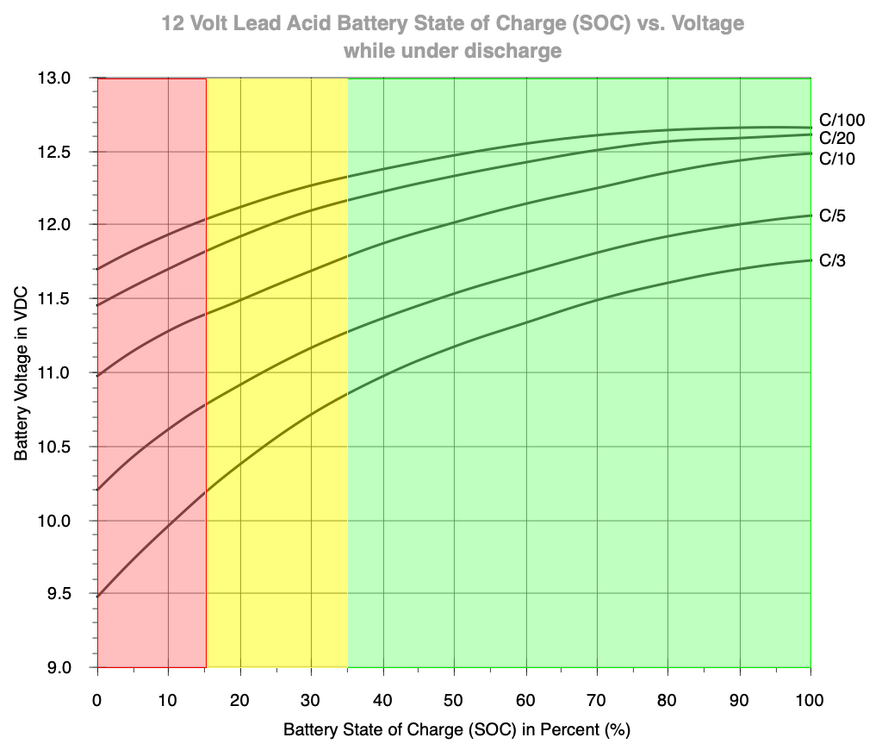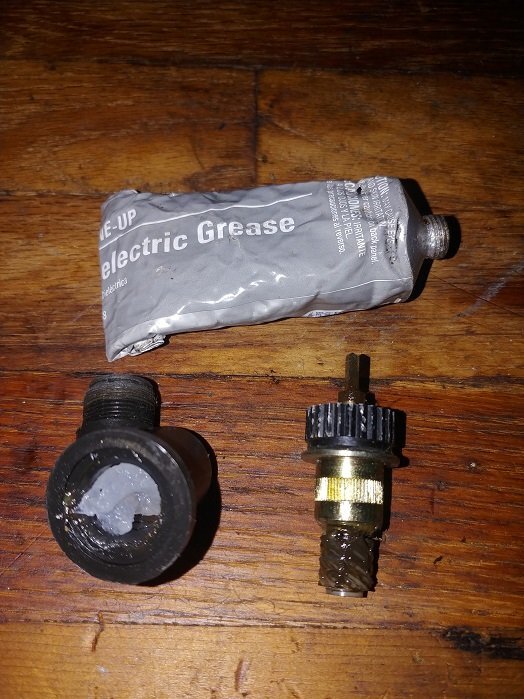-
Posts
1,613 -
Joined
-
Last visited
-
Days Won
64
Content Type
Profiles
Forums
Events
Gallery
Community Map
Posts posted by Pressureangle
-
-
1 hour ago, PJPR01 said:
I felt poor pulling the Krauser Kluge up next to those Sophia Lorens!
-
 2
2
-
 3
3
-
-
-
On 9/21/2025 at 4:30 PM, docc said:
Well, there is continuity through that circuit (good). Not sure if 15 Ohms is high.
What is the Ohm reading from Relay#2 to the black wire at the regulator connector?
Haven't bread each response, on the road- but *any* wire circuit should show very near zero ohms. If the lamps are in this circuit, maybe ok. If not, a serious fault.
-
 2
2
-
-
1 hour ago, Sam P said:
Wiggling the key (turned on) and then the harness attachments to regulator didn't activate any dashboard lights.
I was going to open up the dash to see if there were any loose connections or corrosion inside. Any tips on how to get in there? The three 3mm hex fasteners feel like they may be stripped....
Those screws pass through the mounting plate and thread into the plastic housing below (may have brass inserts, don't have it in hand) but you probably feel the plastic housing dropping away, which you can't see.
-
 2
2
-
-
1 hour ago, docc said:
True, but VRLA, so the voltages are higher overall.
Plus, the Odyssey apparently has some specific charging parameters. Especially either regard to "trickle chargers.
Not so much, really. Unsealed, liquid lead acid needs more float than AGM or VRLA but it's hard even to find those in 12v anymore, usually they're 6v deep cycle.
https://batteryuniversity.com/article/bu-214-summary-table-of-lead-based-batteries-
 1
1
-
-
7 minutes ago, docc said:
Ah - I was going by the 12.3v you reported.
12.84v is 100% for an AGM. Chart below is for a non-AGM lead acid battery.
Pssst. (AGM is still lead-acid)
-
 1
1
-
-
40 minutes ago, gstallons said:
OMG . I used to have to listen to this enlightened idiot that used to tell the margarine/submarine lubricant story all the time. He was the only one of us that was "in the know" and we were a bunch of banjo playin' hillbillies .
lol those things are not mutually exclusive.
Lard, FWIW, was traditionally used to lubricate wooden wheel axles. So eating lubricants isn't off the table. No pun intended but I'll take 'em where I find 'em.
Maybe that hovering dictatorial moderator will put these posts in a "Tin Foil Hat" thread.-
 2
2
-
-
On 9/19/2025 at 5:26 AM, pete roper said:
Lard! Lard is good!
Actually lard is a fantastic lubricant. All animal fats are. The problem is most of them aren’t liquid at room temperature and they get smelly real quick!
One thing they keep very quiet is that sperm whale oil is still used as a lubricant in space vehicles because of its abilities to withstand extremes of circumstance. At least it was at the turn of the millennium. I have to admit I haven’t kept up…...
History is always fun, funny, and maddening. Lard is good.
(From Snopes.com my fav propaganda site)
"Crisco wasn’t invented by or for the German Navy, or for the purpose of lubricating submarines. Hydrogenation, the process by which Crisco is made from vegetable oils, was invented by German chemist Wilhelm Normann in 1901. Whether Crisco or similar products were ever used as submarine lubricants remains undetermined."
"Wilhelm Normann, eventually sold his patent to Procter & Gamble for use in the food market."-
 2
2
-
-
33 minutes ago, Sam P said:
Oil light never turned on iirc, since I have owned the bike.
The battery was at 13v key off this morning, after being on the tender overnight. You are saying this is flat?
To avoid confusion, here's a chart showing battery state-of-charge; this chart is 'under load', which means the top line would be perhaps 'key on' and the bottom line would be 'starter engaged'. This matters because a battery near the end of it's useful life may show good voltage at rest but fail under load. An at-rest lead battery should be 12.6-12.9 volts unloaded.
-
47 minutes ago, Randy said:
I'm running Royal Purple HFS 20W-50 in my flat tappet bikes. It's formulated for those.
That's actually my first go-to if it's available where I need it. That's in the Bimmer at the moment.
-
 2
2
-
-
32 minutes ago, PJPR01 said:
Marfa, Ft. Davis, all nice riding...lots of curves, and a stop at the observatory is an interesting one!
I gather from your route then that you are starting from the East and working your way west. I anticipate being in Atlanta Thursday next week, after picking up stops south of Dallas and then in Dallas area/Greenville, ending up in Atlanta.
Enjoy the riding!
I'm not the guy who routes in stone, just easy to keep stops in Garmin. How about this; I can start about anywhere, let me know where you are going to be Mon/Tues, maybe we can hit a few stops together. I'll PM my cell number.
-
 2
2
-
-
15 hours ago, PJPR01 said:
Aha…next week I’ll be picking up Tour stops in Dallas and Greenville and Atlanta…then up the scenic way thru Arkansas to Missouri and Kansas. Time permitting I may get a few of the extended Republic of Texas Tour as well and then some more standard stops on the way back!
Ojinaga to El Paso…doesn’t look it goes all the way. I’ve only gone the other way to Lajitas along the River road.
Survey says no. Candelaria is the last reach for solo riders on big bikes. Chispa road goes past but is not for tourists. Can take the Mexican side up from there, but uh...no. So I'll keep to the route on the Garmin, cutting back to Marfa.
-
 2
2
-
-
2 minutes ago, Sam P said:
Answers in above quote in BOLD
Data, yummy.
Watch the charge light, with engine off turn key on and wiggle it around, see if lamp lights or flashes.
Do the same while giving the harness the wiggle test at suspected connections.-
 2
2
-
-
17 hours ago, docc said:
I cannot find an image of the earlier bolt, but pretty sure the only change was the finish from the earlier, black phosphate-looking bolts to the later, silver "Geomet corrosion resistant finish " . . .
Certainly, this is group of fasteners that would be unfortunate not to be torqued correctly a.k.a. "tight " . . .
The bolts in this V11 appear to the the same size as the '97 Sport and the '85 Tonti LMIV.
-
 2
2
-
-
15 hours ago, gstallons said:
My apologies , the MOSFET Q3 turns the charge light on. When the voltage is satisfied , Q3 turns off and light goes off.
forginve my ramblings about difference of potential . This is from a long time ago.
Yeah, that's where I started too, until Kiwi Roy's schematic showed up. I confused myself and the thread, but hey we're all learning together.
I guess I *can* change my charge lamp to LED.-
 1
1
-
-
9 minutes ago, GuzziMoto said:
That would be more to my liking. A wider difference between the two numbers means the oil relies more heavily on viscosity modifiers. Viscosity modifiers are complex molecules that coil up when cold and uncoil when they get hot. They are prone to shear, to being cut up, in use. As they get cut up they stop doing what they do. In essence, an oil with a larger gap between the two numbers will breakdown quicker. When you see an oil like 10w-60, it is a 10 weight oil with viscosity modifiers to give it the performance of a 60 weight oil when hot. But those viscosity modifiers that give it the 60 weight when hot aren't as stable and long lasting as the rest of the oil is. So as it gets older under use it gets thinner and thinner when hot. It takes more viscosity modifiers to make a 10w-60 oil then it does a 20w-50 oil.
That said, you can't go wrong using the oil they recommend. I don't agree with their recommendation, but it is their recommendation.
I had a customer back in the early 90s who was head of lubrication engineering at Ashland oil. We had just started racing 883s, so of course discussed thoroughly. He said, "All oils are equal for the first 5 minutes". The extended point was that oil breakdown is more relevant to your motor than what you start with. I could write a dissertation, but here are the high points;
Low viscosity oil is better for cold starts and tight clearances. Not prone to cavitation when cold. Throws off the crank more easily to lubricate cylinder walls better.
High viscosity is better for high temps- because it's thinner at high temp than low viscosity at low temps. Counterintuitive, but often true.
Low viscosity oils at high temperatures can burn and scuff off more easily- a situation that has little concern in watercooled engines but hugely important in air cooled engines.
So while straight-weight oil is what usually finds it's way into strictly racing engines, it's because their operating conditions are stable.
It was true 20-30 years ago that wider W ratings meant the oil broke down more quickly; still true, but not as quickly, and not as completely as before today's supreme quality synthetics. So viscosity breakdown (which usually means the oil thickens at low temps, rather than thins at high) happens well beyond reasonable change intervals. Since I'm in a year-round warm climate, and I rarely ride less than 100 miles at a crack, I use 15w50 Shell Rotella T6 diesel oil as my go-to if I can't source my preferred Klotz V-Twin 15w60. Rotella being a diesel oil still has anti-scuff additives that are gone from gas engine oils, but the detergent package means I change it at 5k miles where the Klotz looks good for 10k. Also, Rotella is half the price of Klotz.
At the end of every oil thread, lies the fact that most engines simply don't much care what you put in them if you change it frequently enough.-
 1
1
-
 1
1
-
-
11 hours ago, PJPR01 said:
Oh I see....you've already done the tour then! That's cool...
No, just planning the route...I'll probably leave here this weekend and begin the tour early next week. First stop is the alt at 3 corners.
Other side of State, but Q in case you know; Can I ride the border from 67 at Ojinaga all the way to El Paso? Do I need to carry more than one spare magazine?
OBTW I've never ridden a Tour Glide further than a test ride after repairs. Really not my style.-
 1
1
-
 2
2
-
-
-
5 hours ago, PJPR01 said:
If you come thru Houston please let me know…can meet at Classic Rock in Navasota!
That's my tour stop #8.

-
 1
1
-
-
3 minutes ago, docc said:
I don't see a size change across the V11 range, @phalford. For sure your caliper mount bolts measure 8mm?
10mm bolt has an 8mm allen socket, that's likely the disconnect.
-
 2
2
-
-
6 minutes ago, docc said:
Thanks for checking! What's that thread pitch?
'coarse'

-
 1
1
-
-
1 hour ago, PJPR01 said:
900 miles in a day on the Norge or the Griso is in the realm of possibility, although I prefer a slower more touring pace rather than an Iron Butt! The Scura would be quite a bit more difficult to do so and enjoy the next day. Hats off for riding the Sporti that many miles!
Did you use that for the Tour of Texas also?
No, I would like to but it's not so. This is my first MCGTT, and my BMW Adventure needs to return to it's home in El Paso so I'm taking the opportunity to kill a few birds with one stone. And of course, the GSA carries everything for self-sufficiency. I plan to tent camp when possible.
Maybe I'll ride out next September and ride you up to Tellico. I need some long days.-
 2
2
-
-
1 hour ago, docc said:
I was going by the Parts Catalog washer size for 1999-2001. Can anyone get a caliper on the actual bolts? @Pressureangle?
My 2000 has 10mm caliper bolts.
-
 1
1
-
-
Here in the US when I have to use a non-preferred oil, for a change on the road, the simplest rule is to avoid any SAE EPA rated oil. The tree huggers have taken pretty much everything out of the oil that doesn't burn in order to keep the catalytic converters active as long as possible. "Classic Car" oils, "Offroad competition", Outboard/marine 4 stroke oils and most OEM motorcycle oils still have good additive packages.
I'm using 15w60 Klotz simply because it tops the charts in protection and I'm in S. Florida/Georgia and never have to worry about starting the engine below 40*F.
The most important reason to use a full synthetic oil is that it stays alive in the valve guides. Natural oils coke up and wear the guides. This is critical in air-cooled engines. H-D had a huge problem with it in the early '70s, so bad the valves would actually sieze in the guides and get bent or bend pushrods.







Clutch Slave Cylinder
in Technical Topics
Posted
Not yet, they don't.